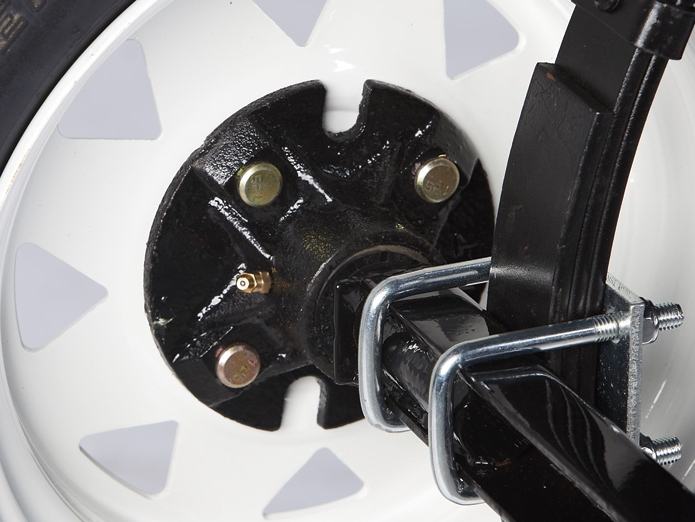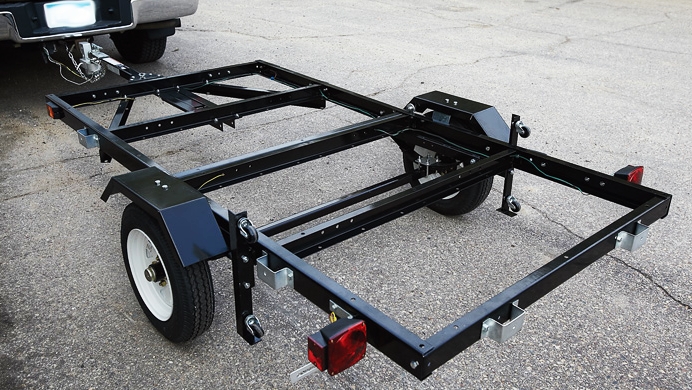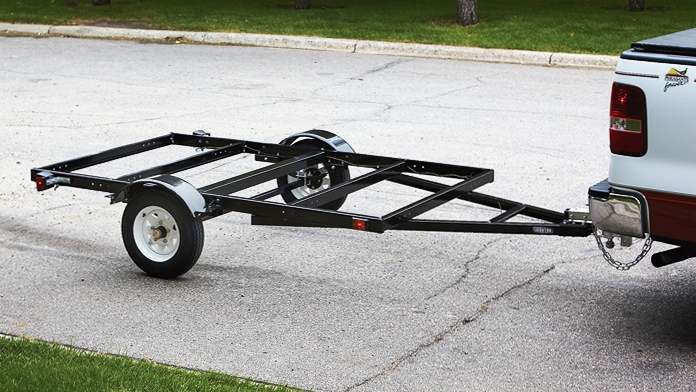Buckle up for the FTC disclosure ride here. The following article was last updated on Nov 20, 2025 ...
A Ride For Your Ride: Finding The Right Motorcycle Trailer
There's certainly more to purchasing a motorcycle trailer than simply measuring a motorbike's dimensions and shelling out the funds. A given rider may own any number of motorcycles from a variety of different genres. Where one motorcycle enthusiast may need a multipurpose toy hauler, the minimal mindset might get by with a single rail above their vehicle's bumper. This points to yet another concern, namely the towing capacity of the vehicle that's doing the hauling.
“There's certainly more to purchasing a motorcycle trailer than simply measuring a motorbike's dimensions and shelling out the funds.”
In this post, we look at five motorcycle trailer types that best represent their intended demographic. Balancing total cost against manufacturing quality, some lean in a more extravagant direction but none supersede safety. All are pull-behind motorcycle trailers (light kit included), so you'll want to know the full extent of your vehicle's towing capabilities before deciding which one's right for you.
Finding a used motorcycle trailer for sale brings an entirely different set of concerns. Licensing/certification, metallurgical condition (rust, be it visible or hidden) and wheel bearings are only a few of the issues buyers must explore. New or used, whichever motorcycle trailer you invest in, be prepared to maintain it! Keeping things operable isn't all that time consuming. Neglect, however, might have disastrous results.
Diamond Cargo's Enclosed Motorcycle Trailer(s)
Pricing: $2000 - $5000
Pros: many styles, sizes and features to choose from
Cons: large storage footprint, more material to maintain
Though the first platform we're looking at is more expensive, enclosed motorcycle trailers are special in that they provide many otherwise inaccessible possibilities. With a bit of modular creativity, owners can pack travel utilities (bedding, cookware, leisure) Tetris style into the front or rear and still have all of the required space for two, three, maybe even four motorcycles. This concept converts our intended message into something far more journey driven.
“See parts of the world you're unfamiliar with. Ride motorcycles. Repeat.”
Diamond Cargo, a Georgia-based company, sells some of the highest-caliber rolling enclosures on the market. Among the basic features which set them apart from the competition are a smaller price tag and 1x1.5 inch square bar frames (most use 1x1). Optional add-ons include insulation, heat/air, storage, panel flooring and interior LED lights.
Purchasing a new motorcycle trailer from Diamond Cargo nullifies any unexpected repair costs that might present themselves after buying a used one. What's more, they offer doorstep delivery to fifty states! Whatever your budget, Diamond Cargo has a trailer to suit and post-purchase upgrades are always possible via their manufacturing, third-party resources or DIY templates.
Kendon's Stand Up Motorcycle Trailer(s)
Pricing: $3000 - $5000
Pros: highest quality in its class, easy to store
Cons: unsheltered/uncovered exposure, higher price range
This next prospect actually raises the price a little. Regardless of square feet, no rider wants their "every so often" motorcycle trailer to occupy valuable garage/storage/work space. Kendon's answer comes in the form of an ultra-robust and foldable stand-up trailer.
The lightweight design of their fully balanced chassis amounts to simple mobility courtesy of industrial-grade rolling casters. An all-American company, said chassis is handcrafted in-house using domestic parts. Single and multiple rail models are readily available, sporting full size tires and an independent suspension!
While this stand-up trailer comes at a more lavish cost than others, its "Grade A" construction more than makes up for it. Buy this folding motorcycle trailer and you'll likely never have to shop for another one again. Backed by an array of warranties targeted at individual components, it's obvious that Kendon's folding stand-up motorcycle trailer is worth more than its weight in trust.
Northern Tool's Folding and Heavy Duty Trailer(s)
Pricing: $400 - $700
Pros: affordable reliability, compact simplicity
Cons: requires a bit of know-how for post-purchase design and construction
Leveling the financial playing field, Northern Tool offers a couple of trailers that are go-to favorites among motorcyclists. For individual motorbikes, their collapsible 4x8 folding trailer is motorcycle-friendly, providing reliable transport in ultra-compact form. Their 5x8 heavy-duty trailers also offer enough space for two or more motorcycles, plus additional functionality.
With bare-bones trailers such as these, some assembly is required. What you're really buying is a frame on wheels that acts as an open canvas for home-built projects. Ingredients for motorcycle use include plywood sheets, bolt-on wheel chocks and tie down anchors.
For three motorcycles, especially if any are of the sport-touring genre, Northern Tool's static (non-foldable) 1,980 lb. capacity heavy-duty trailer is the way to go. Because its footprint is less compact, balancing it vertically in a corner may require some rigging. Either way, it's a perfectly viable and cost-effective option for regular use and out-of-the-way storage.
Hitch Mounted Motorcycle Carriers
Pricing: $150 - $300
Pros: simple, robust transportation with a near zero footprint (easy storage)
Cons: only allows for one motorbike, prospective wear/tear on hauling vehicle's suspension
If you own a vehicular powerhouse with enough torque and suspension to buffer 400-600 lbs in rear leverage, a hitch mounted motorcycle carrier might be for you. Like a rear bicycle rack on steroids, these suspend your motorcycle along a vehicle's rear base (perpendicular to the direction of travel) and speak volumes to why pickup trucks remain the ultimate workhorse. Even with a sport touring motorcycle, their heavy-duty steel construction does the job with confidence.
The carrier's strength is reinforced on installation, secured at two additional locations of the towing vehicle's undercarriage. An easily stowed, fully integrated 72" ramp makes for simple loading/unloading. Their built-in adjustable wheel chock complements four tie-down anchors.
Hitch-mounted motorcycle carriers require a class III or class IV 2" receiver, depending. Without a motorbike onboard, its dimensions are 78.75" long x 8" wide. Because much of its construction is aluminum alloy, its total weight is under 100 lbs, making it an extremely lightweight solution.
Front Wheel Motorcycle Tow Bracket
Pricing: $75 - $300
Pros: It doesn't get any more simple and compact than this!
Cons: Rear wheel on ground, unable to use reverse in the towing vehicle
For those on a budget, front wheel motorcycle tow brackets represent the ultimate in rare use and emergency accessories. Assuming your tow receiver is ready and waiting, getting your motorcycle to and from a nearby point "B" is merely a matter of rolling the front wheel onto a spoon-shaped chock. A strong, powder-coated steel construction accommodates most (manual-shift) motorcycle wheel diameters and widths but that's something you should measure before you buy.
Any current trailer owner will tell you that having the ability to limp a motorcycle for a few (or several) miles without preparing/connecting an entire trailer is convenient. Who knows? With a big enough bike, one of these might fit into your motorcycle's hard luggage if fully dismantled.
With a maximum capacity of 800 lbs, these provide plenty of bang for the buck. A 2x2 inch class II or class III hitch receiver is all that's required. While it's intended more for smaller vehicles and lesser distances, its performance makes it well worth buying.
Motorcycle Trailer Summary
One humorously revisited argument among fellow riders debates the correlation between leaky fork seals and trailering a bike. Where some would suggest the notion of induced damage to be a total farce, others attest to "living the myth" on multiple occasions. Either way, there's no harm in ordering yourself a tie-down brace should you fear the latter.
Looking through our top picks, I have to say that my own personal preference would be to own an enclosed motorcycle trailer. The reason for my decision has more to do with its multipurpose possibilities than anything else. Imagine fully customizing an 28 foot enclosed cargo trailer to act 25% as a garage and 75% as an insulated, climate controlled fifth wheel RV!
This imaginative modular mindset makes migratory motorcycling a year-round possibility (say that five times fast). If your motorcycle trailer purchase comes from the info presented above, take satisfaction in your investment. For those unfortunate situations where riding to your starting point is too much of an inconvenience, your ride can ride in style.

What Motorcycle Trailers Do You Use?
There are many motorcycle trailers on the market. Which ones have you tried? What do you like about yours and why? Your input is invited. Leave a comment and/or write an article!



































Comments
I'm delivering a motorcycle to my brother about 700 miles away and didn't want to strap it to my waste hauling trailer. I really like the idea of having a folding trailer as I think it would suit my needs perfectly and isn't terribly expensive. I will definitely keep my eye out. Thanks for sharing!
Looking for the right trailer for honda rebel 250 I drive a 2008 honda civic lx and I am in the process of getting a trailer receiver installed on my car and need the right trailer. I need to pick up my bike in florida I live in pennsylvania can you help
@William - First I want to say I'm impressed that your car has a towing capacity of 1000 lbs. When you suggested it being your tow vehicle, I immediately looked that up.
The Rebel 250 is a pretty lightweight machine. If it were me, I'd buy a tow ball connection that's both compatible with your car's insert and the Northern Tool single rail.
If you get me the specifics on your car's insert, I might be able to do a bit of digging around the web for said tow ball.
Thank you for the article! I'm still pondering what to do. I have a 1990 Ford Econoline E250 Class B RV van and would like to carry a lightweight enduro motorbike (under 250 pounds) in addition to my stowaway/swingaway carrier. Is this possible? Can't I just get a versa haul and put both the bike and stowaway on in tandem? I think I have a 500 lb. tongue weight but I am not sure what that means exactly. Suggestions? Thanks again for the information in your article :)
- Melissa
What an adventurous life you lead! My wife and I have a vested interest in your question as we're considering similar living/travel conditions. Regarding tongue weight and your van's year/make/model, here's what you'll want to consider:
1) Find out the exact tongue-weight capacity for sure (don't estimate)
Tongue weight represents the absolute-vertical weight capacity of your vehicle's tow connector at the bumper. Let's say it's 500 lbs (again, get an exact figure). Now imagine a 500 lb motorcycle hanging directly over the tow ball outlet. This is basically the maximum capacity that your vehicle is designed to handle in terms of "at the bumper" downforce plus or minus any shift in said weight while driving over bumps or hills (or bumpy hills). It's all about flexing metal and suspension travel.
2) Don't daisy chain unless your equipment specifies that doing so is okay
Attaching "one-component-to-another-component-to-a-vehicle" raises the issue of some pretty crazy geometry. That geometry can get risky pretty fast, so refer to each individual element's manual before (not) stacking your connections. There's no harm in contacting the manufacturer either, assuming they're willing to discuss the concept. As I'll mention again later in this response, don't gamble. Get your math in order and consider the figures.
3) Consider the age/condition of your vehicle
Whether your van is seemingly mint or rusty, you're dealing with whatever OEM and upgraded engine, chassis and wheel parts are currently in operation amongst others that are 25+ years old. My point is that you should ask yourself: how does this vehicle feel in terms of performance when it's not towing anything at all? If the answer is "pretty good" then I'd say that's enough to begin looking at just how much leveraged weight keeps it running/performing well enough without any obvious strain.
4) Know your suspension
Adding the heavier of the two items closer to the chassis helps - BUT - leverage is leverage. Once you've validated the weight capacity as "safe" and even before mentally processing the vehicle's mid-drive "happiness" (step 2, see above), consider how far everything is going to stick out from the back and eyeball the leverage it places on your rear wheel's suspension. The farther out it sticks, the more it's going to demand of your chassis and shocks + the tongue weight will changing, shifting up/down quite a lot, in bumpier areas. It might also compress the rear end substantially, giving rise to the front wheels and making the van's overall handling bizarre.
In short ... test, test and test. Then, test some more. Safety first!
"If it were me" (LOL), I'd go with a well-balanced trailer. In many cases, pulling is easier than carrying. A trailer that's been properly loaded will be mostly (if not completely) balanced. You can test the tongue weight after the fact, in favor of safer travel.
IMPORTANT: Placing more weight to the REAR of a tow-behind trailer creates FAR MORE INSTABILITY (dangerous) than the latter. Your best bet, should you decide to "tow" instead of "load" (versa haul), would be to keep heavier items toward the front (effects tongue weight) if not aiming for that "perfect" balance toward the middle/center (more ideal).
I hope that helps!
Anyone have any recommendations for someone with two 150cc scooters, which I would like to tow behind an RV?
With the front wheel tow bracket, how far (and at what speed) can you travel? I own a '04 ultra classic cruiser and am interested in this.
That depends purely on which cradle you buy. A lot of specs are listed on reseller pages as well as manufacturing websites. A bit of data mining (Google) and you'll narrow your search to suit.
How much does that bike weigh?
I use an Ironhorse Trailer. They do cost more but it was worth every penny. It is light weight aerodynamic, and easy on my gas tank. I do not haul that often but i store my bike inside of it while in the garage to save on space. I went with the electrical outlet option and leave a battery tender on it while the trailer is plugged up. I also like the stabilizer legs in the rear that allow me to load and unload without being hooked up to a vehicle. It came new with 4 years of warranty, wheel matching spare, ride in step off wheel chock, and D-rings.
While IronHorse trailers *appear* to be angled more toward the cruiser crowd (not our demographic), I can't deny the luxuries you mention are as convenient as it gets. Solid sheltering, power access, ease-of-use ... great comment, Jamie.
The down side though, one that's difficult to ignore, is that their footprint is as massive as any enclosed trailer - but - if it fits your use and you have the space, who cares?
Buy what works. Easy peasy.
I really like the single rail folding trailer from Northern Tool but they no longer list it on their site. Searching the web, a thousand results pop up.
Does anybody know where to find the same trailer?
I've spent hours looking.
That's a solid and fair questions, William.
I predict that said trailer was rebranded, meaning it was made by a 3rd party and licensed to be listed as a Northern Tool product.
I'll do what research I can to find out the name of the manufacturer. If you or anyone else beats me to the punch, please make mention of it here in the comments!
Update: I contacted Northern Tool directly. Seems this product was shipped and rebadged (as predicted) from overseas. The 3rd-party manufacturer has discontinued it. I asked that they update us when something comparable (small, single-rail, folding) finds its way into their catalog. Until then, we're all on the hunt.
Better: Kendon's single motorcycle trailer is the wiser investment. It's sturdier, safer and more reliable + plenty compact. Drop the extra scratch and reap the rewards.
I might have to drive across country and am looking to bring my bike with me. Only problem is I’m not sure how safe it would be to tow behind my Prius.
I have a 2015 Prius and a 2015 Honda Grom (weight of 200lbs) and would be traveling from Los Angeles to Boston. I’d like to bring it with me safely, but not sure if that can be done with a front wheel tow bracket. Any suggestions?
Even if I knew the warranty specifics for your Prius, I wouldn't use a front wheel tow bracket for that kind of distance.
My suggestion is to first read what is and isn't allowed for that car. Then, either install a hitch + small trailer or just ship it to your destination.
I have a 950 lb Harley and was interested in the hitch trailer. I don’t see where to find these. Your article says it will hold 1980lbs. I did find one on Amazon but it only holds 600lbs
It looks like they ditched that version of the trailer. Their 5x8 can handle 1715 lbs, so that might do ya.
What is the brand and model in the Front Wheel Motorcycle Tow Bracket picture in the article (with the BMW on it)?
@MPW ...
Ebay listings (linked below the image) label it as "unbranded", whatever that means.
Important to note that it's most definitely an emergency, last resort option. I wouldn't want to use that for more than a few miles and you certainly won't see me going down the highway with it. It's too minimal for anything long range in my opinion.
That stated, I still say it's a workable solution under the right circumstances and compact to boot.
Thoughts gone wild? Write an article!